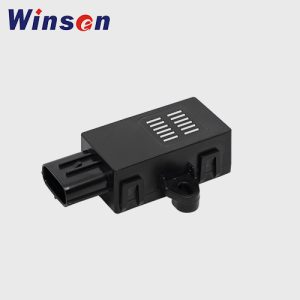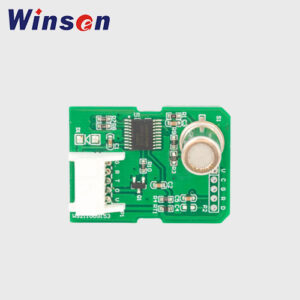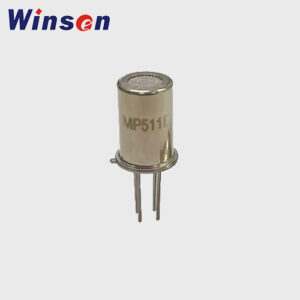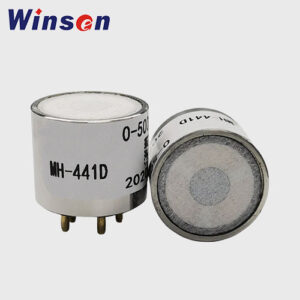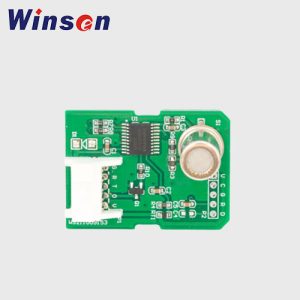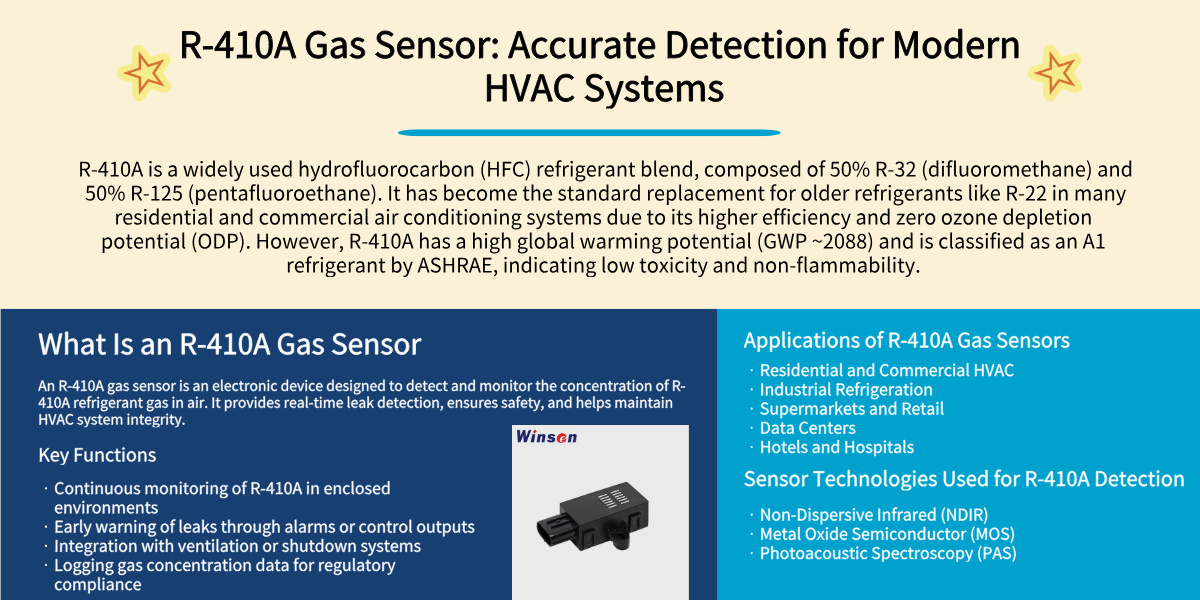Best Refrigerant Sensor Manufacturer & Supplier
Refrigeration and air conditioning systems play an essential role in the United States, supporting everything from residential comfort to industrial food storage, data centers, and medical facilities. At the heart of these systems are refrigerants—chemical compounds that absorb and release heat, enabling cooling. However, refrigerants can be hazardous when they leak. Some pose direct safety risks such as flammability or toxicity, while others contribute to climate change due to their high Global Warming Potential (GWP).
Refrigerant sensors are specialized devices designed to detect and monitor refrigerant leaks. In the U.S., their importance has grown significantly due to strict EPA regulations, ASHRAE safety standards, and the Susog sa Kigali implementation, which is driving the phase-down of high-GWP refrigerants. These sensors are not just compliance tools; they are essential for safety, environmental protection, and efficient HVACR (Heating, Ventilation, Air Conditioning, and Refrigeration) system operation.
Types of Refrigerant Sensors
- NDIR (Non-Dispersive Infrared) Sensors
- Semiconductor Sensors (MOS)




Refrigerant Sensor - Factory Wholesale Available Worldwide
Zhengzhou Winsen Electronics Technology Co., Ltd., a Chinese stock market listed company since 2009, is a professional manufacturer with 30+ years of experience in gas sensing technology. We provide the most complete sensing solutions with 7 categories and 200+ series, covering gas sensors, pressure, flow, humidity sensors, and related instruments. Our products are widely applied in household, automotive, medical, industrial safety, fire prevention, smart city, and environmental monitoring, trusted by global partners for reliability, innovation, and quality.
Long operational lifespan
Stable calibration
High sensitivity
Fast response and recovery time
NDIR Refrigerant Sensor
Semiconductor Refrigerant Sensor
Technical Comparison of Semiconductor (Metal Oxide) vs. Infrared (NDIR) Refrigerant Sensors
| Feature | Semiconductor (Metal Oxide) Sensors | Infrared (NDIR) Sensors |
|---|---|---|
| Working Principle | React to refrigerant gas by altering the conductivity of a metal oxide surface. | Use Non-Dispersive Infrared (NDIR) absorption to detect specific gas wavelengths. |
| Pros | – Cost-effective – Compact design – Quick response to basic gas detection | – High accuracy – Long operational life – Specific to target refrigerants (low cross-sensitivity) |
| Cons | – Susceptible to cross-sensitivity (false readings from other gases) – Affected by humidity | – Higher initial cost – Slower response time – Larger physical footprint |
| Ideal For | Budget-sensitive applications, simple leakage alarms, or non-critical environments | Precision-driven systems, industrial monitoring, or applications requiring high reliability |
Market Applications in the United States

1. Commercial HVAC
Office buildings, hotels, and malls.
Sensors ensure compliance with ASHRAE 15 and prevent refrigerant buildup in confined spaces.

2. Cold Storage and Supermarkets
Refrigerated display cabinets, cold rooms, and freezers require leak detection to maintain product integrity and minimize refrigerant loss.

3. Residential HVAC and Heat Pumps
Growing adoption due to new refrigerants like R-32 and R-454B (mildly flammable A2L refrigerants).
U.S. homeowners increasingly require sensors for safety.

4. Industrial Refrigeration
Food storage warehouses, cold chain logistics, pharmaceutical facilities.
Ammonia and CO₂ sensors are critical.

5. Aerospace
Refrigerant sensors protect cabin safety in aircraft HVAC systems.

6. Automotive
U.S. cars are shifting to R-1234yf (low GWP).
Sensors detect leaks in EV battery cooling systems.
Why Global Clients Choose Us?
The company consistently adheres to the quality policy of “Fine Craftsmanship, Scientific Innovation, Pursuit of Excellence, and Value-Added Service.” By formulating production process control plans and work instructions, it has established a standardized, accountable, and regulated process management system. Additionally, the company has independently developed an MES production management system, enabling comprehensive and visual management across the entire workflow.

30+ YEARS OF EXPERIENCE
R&D, manufacture and sales of sensors and sensing solutions.
QUALITY GUARANTEE CONTINOUS IMPROVEMENT
Complete and rigid process flow control, coupled with significant improvements.


INTERNATIONAL MARKET
Deliver sensing products to more than 100 countries and regions.
STABLE SUPPLY CHAIN RELIABLE PRODUCTION
Core components not subject to constraints, advanced equipments for manufaturing and test.


R&D STRENGTH TECHNOLOGY INNOVATION
200+ patents, 180+ R&D team members, self-built labs for continous innovation.
ONE-STOP SERVICE
Professional consultation, fast delivery, 24 hours after-sales support.

Leading the Industry, Innovative & Controllable Technology
With robust R&D capabilities, we maintain sustained input in R&D and unwavering commitment to technological innovation. This not only ensures that we remain at the forefront of industry but also drives continuous innovation, leading the future trend of the sensing industry.

10% R&D Input
The average annual R&D input exceeds 10% of the annual revenue.
5+ R&D Layout
With Zhengzhou headquarters as the core, a nationwide R&D and innovation system is being established, encompassing cities of Shanghai, Wuhan, Shenzhen, and Taiyuan.
180+ R&D Team
There are over 180 R&D personnel, including more than 10 with doctoral degrees and over 50 with master's degrees, who have an average of more than 8 years of experience in sensor development.
20+ Experiment Types
Gas-related, Climatic Environment, EMC, Electrical Performance, Mechanical Performance, etc.
10+ Advanced Laboratories
CNAS Laboratory, MEMS Laboratory, UL Laboratory, Nanocomposite Materials Laboratory, etc.
400+ sets Leading R&D Equipment
Cube Storage, Die Bonder, Lithography Machine, Coating Machine, SMT Placement Machine, Automatic Probe Station, etc.
Humiling ng Konsultasyon
U.S. Regulatory Landscape
Q1: Are refrigerant sensors mandatory in the U.S.?
Yes, in machinery rooms and industrial refrigeration per ASHRAE 15 and EPA Section 608.
Q2: How often should refrigerant sensors be calibrated?
At least once per year.
Q3: Which refrigerants require the most sensitive sensors?
Flammable A2L/A3 refrigerants and toxic refrigerants like ammonia.
Q4: Are there wireless refrigerant sensors in the U.S. market?
Yes, IoT-based sensors are gaining popularity.
Frequently Asked Questions (FAQs) about Refrigerant Sensors
1. What is a refrigerant sensor?
A refrigerant sensor is a device used to detect the presence and concentration of refrigerant gases in systems such as HVAC, refrigeration units, and automotive air conditioning. It plays a vital role in ensuring safety, efficiency, and environmental compliance by identifying leaks or abnormal gas levels.
Refrigerant Sensor: Principles, Applications, and Importance in Modern Systems
2. How does a refrigerant sensor work?
Refrigerant sensors detect gases using technologies such as infrared (IR) absorption, electrochemical reactions, semiconductor conductivity, or photoacoustic effects. Each method identifies refrigerant gases by measuring specific physical or chemical changes caused by their presence.
3. Why are refrigerant sensors important?
Refrigerant sensors are essential for maintaining safety by detecting leaks that can be hazardous or flammable. They also ensure system efficiency by monitoring refrigerant levels and help meet environmental regulations by preventing harmful gas emissions.
4. Where are refrigerant sensors commonly used?
These sensors are used in a variety of applications, including HVAC systems, commercial and industrial refrigeration, automotive air conditioning, and environmental monitoring systems. They are also found in areas where refrigerant leaks could pose health or safety risks.
5. How often should a refrigerant sensor be calibrated?
Most refrigerant sensors should be calibrated at least once a year. However, calibration frequency may increase depending on environmental conditions, regulatory requirements, or the critical nature of the application.
6. What are signs of a failing refrigerant pressure sensor?
Common signs include warm air from air conditioning vents, erratic system behavior, frequent compressor shutdowns, and warning lights on the control panel. These symptoms suggest the sensor may not be accurately detecting pressure or gas levels.
7. Can I test a refrigerant pressure sensor myself?
Yes, testing can be done using tools like a multimeter, pressure gauges, or diagnostic scanners. However, due to the technical nature of HVAC systems, it’s often recommended to have a professional perform diagnostics to ensure accurate results and safe handling.
8. How long does a refrigerant sensor typically last?
The lifespan of a refrigerant sensor varies depending on the operating environment and maintenance practices. Under normal conditions and with regular servicing, a sensor can last several years. Harsh or corrosive environments may reduce its lifespan.
9. What maintenance is required for refrigerant sensors?
Regular inspection, cleaning, and calibration are the main maintenance tasks. It’s also important to keep the sensor dry, avoid physical damage, and replace it promptly if it shows signs of malfunction or inaccuracy.
10. Are refrigerant sensors required by law or regulations?
Yes, in many regions, standards such as EN 378 in Europe and ASHRAE 15 in the United States require refrigerant leak detection for safety and environmental protection. Compliance with these regulations often mandates the use of reliable and properly calibrated refrigerant sensors.

